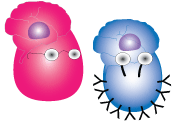
How regulatory T cells work
Just to finish off the T cell section, let's have a look at how Tregs work!
There are many ways by which Tregs can stop unwanted immune responses by effector T cells that are either self-reacting or specific for harmless antigens. How they do this partly depends on which kind of Treg we are dealing with, be it the nTregs that develops in the thymus, or the inducible Tregs (iTregs, Th3 and Tr1) that develop in the secondary lymphoid organs. In the graphic you can see two different Tregs trying to silence a self-reactive effector T cell, that for some reason is attacking our normal healthy epithelium, perhaps lining the gut. Before you go on reading, take a closer look and see if you can identify a few different ways by which these Tregs may be stopping the self-reacting effector T cell. Did you notice the TGF-β and IL-10 that the Tr1 cell was secreting? These suppressive cytokines can act directly on the effector T cells and suppress them by stopping them from dividing, but they can also work indirectly via the APC which, in this case, is a DC. Perhaps you remember from the linker module that TGF-β and IL-10 suppressed DC maturation and as we know an immature DC is not a great antigen presenting cell, that in addition is prone to drive differentiation of naive T cells down the Treg route. The nTreg in this picture also directly interacts with the DC and in this interaction a surface molecule called CTLA-4 is of particular interest. CTLA-4 has got stronger binding capacity for the costimulatory molecules CD80 and CD86 expressed on the DC, than what the CD28 on the effector T cell has. This means that the effector T cell suddenly will have to compete for costimulation, and I'm sure you know what happens to a T cell that doesn't get enough costimulation!? The CTLA-4 interaction also makes the DC start producing an enzyme called indoleamine 2,3-dioxygenase (IDO). IDO can break down the amino acid tryptophan, which is an essential metabolite that effector T cells need for dividing, but this break-down also results in pro-apoptotic metabolites that in themselves can suppress the effector T cell. Inhibitory cytokines, metabolic disruption and suppression by modulating DCs, as seen here, are just a few ways by which Tregs can stop unwanted immune responses.